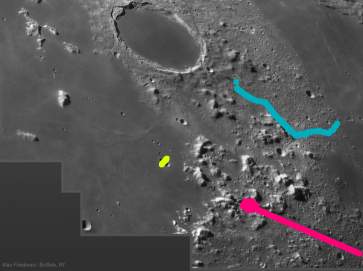This Astronomy Picture of the Day photo of Plato and surrounds on Luna has three interesting features on it which are not even mentioned (bar one, and that barely) in the accompanying text; use this thumbnail as a key, and open the APOD image in a new window:

The blue line traces a gully, kinda-sorta, which has its wide end near Plato — that is, uphill — and the skinny end on a lunar mare (plain) — downhill — but perhaps even more interesting is that it is discontinuous. The riddle: How was it made?
There is a similar feature near Aristarchus, called Schroter’s Valley (Valles Schroter) or Schroter’s Rille, and a different-but-intriguing linear rille (that photo was taken by an Apollo astronaut wielding a film camera).
The pink splitpin outlines the amazingly straight lunar Alpine Valley, which (as you can see in this image) also has a wandering, sputtery more-or-less central channel-ish. Why straight? Why does it have a flat “pool” at one end? How did the central channel form?
The yellowish bar highlights what appears to be a ridge thrown up between adjacent craters; does this indicate that they were formed together?
Comments